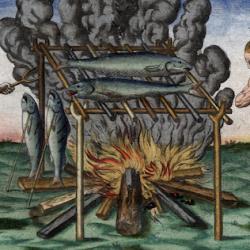In his book, Disenchanted Night, Wolfgang Schivelbusch considers the difference between lighting by torches and lighting with candles. With the torch, “the site of combustion and the fuel are one and the same thing, while in the candle they are clearly separated. From now on the wick acts as the sole site of combustion, and it is fed the material the flame needs by the fuel reservoir (the wax cylinder of the candle, the container of oil in the lamp), kept neatly distinct from the flame. The torch had remained a clearly recognizable, if much changed, log of wood from the hearth fire.”
The wick brought a different experience of fire: “The flame flickering around a wick for the first time burned totally and exclusively for the purpose of giving light. The wick was as revolutionary in the development of artificial lighting as the wheel in the history of transport. Psychologically, this technical innovation was extremely significant. Seeing a flame burning around an almost imperceptible wick is a very different experience from seeing a flame flickering around a log or a torch. The log and the torch are physically consumed by the process of burning, but the flame burns around the wick without any visible sign of destruction. The wick remains unchanged (merely requiring to be ‘trimmed’ from time to time, and even that was unnecessary by the beginning of the nineteenth century), and it is only the fuel feeding it that diminishes. But this takes place at a rate so slow that an observer can perceive it only over a relatively long period of time.”
The wick was an advance in human control of fire, psychologically if not in reality: “In the torch, people experienced the elemental, destructive power of fire—a reflection of their own still-untamed drives. In the candle flame, burning steadily and quietly, fire had become as pacified and regulated as the culture that it illuminated” (6). Consider the wick: Tamed fire.















